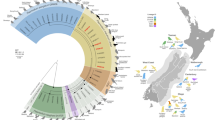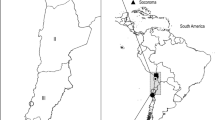Abstract
The cattle tick Rhipicephalus (Boophilus) microplus was first reported in West Africa in Ivory Coast, in 2007. Since then it has made an aggressive eastward advancement having been reported in four other West African countries: Mali, Burkina Faso, Togo and Benin. We herein report the first molecular identification of this tick species in Nigeria, West Africa, and highlight the threat it poses to livestock health. A nation-wide tick survey was conducted in 12 out of 36 states across the various agro ecological zones of Nigeria over a 1 year period (April 2014–March 2015). In total 1498 ticks belonging to three genera collected from cattle were morphologically identified. Overall, Amblyomma species constituted the highest percentage of sampled ticks, 50.2% (752/1498), followed by Rhipicephalus (including the subgenus Boophilus) species, 29.4% (440/1498) and Hyalomma species, 20.4% (306/1498). The presence of Rh. (B.) microplus was identified morphologically from four out of the 12 states. This finding was confirmed for the first time in Nigeria using a molecular method targeting the ITS-2 region of the ticks in three of the 12 states. This study ascertained the presence of Rh. (B.) microplus in Nigeria in addition to a broad variety of cattle tick species, most of which are of veterinary importance. The implication of this finding is that there may be additional economic burden to livestock farmers due to increased cost of tick control occasioned by the acaricide resistance by this tick species widely reported from different climes. Additionally, there may be a potential upsurge in incidence of hemoparasitic infections in cattle leading to increased morbidity, cost of treatment and mortalities.



Similar content being viewed by others
References
Adakal H, Stachurski F, Chevillon C (2013) Tick control practices in Burkina Faso and acaricide resistance survey in Rhipicephalus (Boophilus) geigyi (Acari: Ixodidae). Exp Appl Acarol 59(4):483–491
Ameen SA, Odetokun IA, Ghali-Muhammed LI, Azeez OM, Raji LO, Kolapo TU, Adedokun RAM (2014) Status of ticks infestation in ruminant animals in Ogbomoso area of Oyo state, Nigeria. J Environ Issues Agric Dev Ctries 6(2 & 3):48–53
Awa DN, Adakal H, Luogbou NDD, Wachong KH, Leinyuy I, Achukwi MD (2015) Cattle ticks in Cameroon: is Rhipicephalus (Boophilus) microplus absent in Cameroon and the Central African region? Ticks Tick Borne Dis 6:117–122
Baffi MA, de Souza GR, de Sousa CS, Ceron CR, Bonetti AM (2008) Esterase enzymes involved in pyrethroid and organophosphate resistance in a Brazilian population of Riphicephallus (Boophilus) microplus (Acari, Ixodidae). Mol Biochem Parasitol 160(1):70–73. doi:10.1016/j.molbiopara.2008.03.009
Barton NH (1979) The dynamics of hybrid zones. Heredity 43:341–359
Berkvens DL, Geysen DM, Chaka G, Madder M, Brandt JRA (1998) A survey of the ixodid ticks parasitizing cattle in the Eastern province of Zambia. Med Vet Entomol 12:234–240
Chen Z, Liu Q, Liu JQ, Xu BL, Lv S, Xia S et al (2014) Tick-borne pathogens and associated co-infections in ticks collected from domestic animals in central China. Parasit Vector 7:237
Dantas-Torres F, Chomel BB, Otranto D (2012) Ticks and Tick Borne diseases: a One Health perspective. Trends Parasitol 28(10):437–446
De Clercq EM, Vanwambeke SO, Sungirai M, Adehan S, Lokossou R, Madder M (2012) Geographic distribution of the invasive cattle tick Rhipicephalus microplus, a country-wide survey in Benin. Exp Appl Acarol 58:441–452
De Vos AJ, Potgieter FT (1994) Bovine babesiosis. In: Coetzer JAW, Thomson GR, Tustin RC (eds) Infectious diseases of livestock, with special reference to Southern Africa. Oxford University Press, Cape Town, pp 278–291
Estrada-Peña A (2001) Climate warming and changes in habitat suitability for Boophilus microplus (Acari: Ixodidae) in Central America. J Parasitol 87:978–987
Estrada-Peña A, Venzal JM (2006) High-resolution predictive mapping for Boophilus annulatus and B. microplus (Acari: Ixodidae) in Mexico and Southern Texas. Vet Parasitol 142:350–358
Estrada-Peña A, Bouattour A, Camicas J-L, Guglielmone A, Horak I, Jongejan F, Latif A, Pegram R, Walker AR (2006) The known distribution and ecological preferences of the tick subgenus Boophilus (Acari: Ixodidae) in Africa and Latin America. Exp Appl Acarol 38:219–235
Evans DE, Martins JR, Guglielmone AA (2000) A review of the ticks (Acari, Ixodida) of Brazil, their hosts and geographic distribution—1. The state of Rio Grande doSul, Southern Brazil. Mem Inst Oswalso Cruz Rio de Janeiro 95:453–470
Eyo JE, Felicia Ekeh N, Ivoke N, Atama CI, Onah IE, Ezenwaji NE, Ikele CB (2014) Survey of tick infestation of cattle at four selected grazing sites in the tropics. Glob Vet 12(4):479–486
Jabbar A, Abbas T, Sandhu ZD, Saddiqi HA, Qamar MF, Gasser RB (2015) Tickborne diseases of bovines in Pakistan: major scope for future research and improved control. Parasit Vector 8:283
Jameson LJ, Morgan PJ, Medlock JM, Watola G, Vaux AGC (2012) Importation of Hyalomma marginatum, vector of Crimean-Congo haemorrhagic fever virus, into the United Kingdom by migratory birds. Ticks Tick Borne Dis 3:95–99
Katsande TS, MazhowuTurton JA, Munodzana D (1996) Babesia bovis case reports and the current distribution of Boophilus microplus in Zimbabwe. Zimb Vet J 27:33–36
Lawrence JA, Williamson SM (2004) Theileria velifera infection. In: Coetzer JAW, Tustin RC (eds) Infectious diseases of livestock, 2nd edn. Oxford University Press, Cape Town, pp 483–484
Leger E, Vourc’h G, Vial L, Christine CC, McCoy KD (2013) Changing distributions of ticks: causes and consequences. Exp Appl Acarol 59:219–244
Lempereur L, Geysen D, Madder M (2010) Development and validation of a PCR-RFLP test to identify African Rhipicephalus (Boophilus) ticks. Acta Trop 114:55–58
Lew-Tabor AE, Bruyeres AG, Zhang B, Valle MR (2014) Rhipicephalus (Boophilus) microplus tick in vitro feeding methods for functional (dsRNA) and vaccine candidate (antibody) screening. Ticks Tick Borne Dis 5(5):500–510
Lorusso V, Picozzi K, de Bronsvoor MC, Majekodunmi A, Dongkum C, Balak G, Igweh A, Welburn SC (2013) Ixodid ticks of traditionally managed cattle in central Nigeria: where Rhipicephalus (Boophilus) microplus does not dare (yet?). Parasit Vectors 6:171
Low VL, Tay ST, Kho KL, Koh FX, Tan TK, Lim YAL, Ong BL, Panchadcharam C, Norma-Rashid Y, Sofian-Azirun M (2015) Molecular characterization of the tick Rhipicephalus microplus in Malaysia: new insights into the cryptic diversity and distinct genetic assemblages throughout the world. Parasit Vectors 8:341
Lynen G, Zeman P, Bakuname C, Di Giulio G, Mtui P, Sanka P, Jongejan F (2008) Shifts in the distributional ranges of Boophilus ticks in Tanzania: evidence that a parapatric boundary between Boophilus microplus and B. decoloratus follows climate gradients. Exp Appl Acarol 44:147–164. doi:10.1007/s10493-008-9134-1
Madder M (2012a) I-Spot key for the identification of R Boophilus females. http://www.ispot.org.uk/webkeys/keyintroduction.jsp?selectedKey=webkeys/Rhipicephalus%28Boophilus%29_females.0.1
Madder M (2012b) I-Spot keys for the identification of R. Boophilus males. http://www.ispot.org.uk/webkeys/keyintroduction.jsp?selectedKey=webkeys/Rhipicephalus%28Boophilus%29_males.0.2
Madder M, Thys E, Geysen D, Baudoux C, Horak I (2007) Boophilus microplus ticks found in West Africa. Exp Appl Acarol 43:233–234
Madder M, Thys E, Achi L, Toure´ A, De Deken R (2011) Rhipicephalus (Boophilus) microplus: a most successful invasive tick species in West-Africa. Exp Appl Acarol 53:139–145
Madder M, Adehan S, De Deken R, Adehan R, Lokossou R (2012) New foci of Rhipicephalus microplus in West Africa. Exp Appl Acarol 56:385–390
Mason CA, Norval RAI (1980) The ticks of Zimbabwe. 1. The genus Boophilus. Zimb Vet J 11:36–43
McLeod J, Mwanaumo B (1978) Ecological studies of ixodid ticks (Acari: Ixodidae) on cattle in Zambia. IV: some anomalous infestation patterns in the northern and eastern regions. Bull Entomol Res 68:409–429
Musa HI, Jajere SM, Adamu NB, Atsanda NN, Lawal JR, Adamu SG, Lawal EK (2014) Prevalence of tick infestation in different breeds of cattle in Maiduguri, Northeastern Nigeria. Bangl J Vet Med 12(2):161–166
Norval RAI, Fivaz BH, Lawrence JA, Daillecourt T (1983) Epidemiology of tick-borne diseases of cattle in Zimbabwe. I. Babesiosis. Trop Anim Health Prod 15:87–94
Norval RAI, Perry BD, Hargreaves SK (1992) Tick and tick-borne disease control in Zimbabwe: what might the future hold? Zimb Vet J 23:1–15
Obadiah HI, Shekaro A (2012) Survey of tick infestation in cattle in Zaria abattoir, Nigeria. J Vet Adv 2(2):81–87
Oduguwa BO, Oloyo OO, Talabi AD, Sogunle OA, Okwelum N, Oloyo RA (2013) Assessment of tick infestation and its effects on growth of extensively managed cattle in Ogun State, Nigeria. Niger Vet J 34(1):701–708
Ogungbenro SB, Morakinyo TE (2014) Rainfall distribution and change detection across climatic zones in Nigeria. Weather Clim Extrem 5–6:1–6
Oguntunde PG, Abiodun BJ, Lischeid G (2011) Rainfall trends in Nigeria, 1901–2000. J Hydrol 411:207–218
Opara MN, Ezeh NO (2011) Ixodid ticks of cattle in Borno and Yobe states of Northeastern Nigeria: breed and coat colour preference. Anim Res Int 8(1):1359–1365
Regassa SL (2012) Analysis of habitat suitability for Rhipicephalus (Boophilus) ticks in Benin. MSc thesis No 168, Institute of Tropical Medicine, Antwerp, Belgium
Rich SM, Rosenthal BM, Telford SR 3rd, Spielman A, Hartl DL, Ayala FJ (1997) Heterogeneity of the internal transcribed spacer (ITS-2) region within individual deer ticks. Insect Mol Biol 6(2):123–129
Sanders CJ, Mellor PS, Wilson AJ (2010) Invasive arthropods. Rev Sci Tech Off Int Epiz 29:273–286
Smeenk I, Kelly PJ, Wray K, Musuka G, Trees AJ, Jongejan F (2000) Babesia bovis and B. bigemina DNA detected in cattle and ticks from Zimbabwe by polymerase chain reaction. J South Afr Vet Assoc 71(1):21–24
Sutherst RW (1987) The dynamics of hybrid zones between tick (Acari) species. Int J Parasitol 17:921–926
Sutherst RW, Maywald GF (1985) A computerised system for matching climates in ecology. Agric Ecosyst Environ 13:281–299
Tabar MD, Altet L, Francino O, Sánchez A, Ferrer L, Roura X (2008) Vector-borne infections in cats: molecular study in Barcelona area (Spain). Vet Parasitol 151:332–336
Tamura K, Peterson D, Peterson N, Stecher G, Nei M, Kumar S (2011) MEGA6: molecular evolutionary genetics analysis using maxium likelihood, evolutionary distance, and maximun parsimony methods. Mol Biol Evol 28:2731–2739
Tongjura JDC, Amuga GA, Ombugadu RJ, Azamu Y, Mafuiya HB (2012) Ectoparasites infesting livestock in three local government areas of Nasarawa state, Nigeria. Sci World J 7(1):15–17
Tonnesen MH, Penzhorn BL, Bryson NR, Stoltsz WH, Masiwigiri T (2004) Displacement of Boophilus decoloratus by Boophilus microplus in the Soutpansberg region, Limpopo province, South Africa. Exp Appl Acarol 32:199–208
Uilenberg G (1981) Theilerial species of domestic livestock. In: Irvin AD, Cunningham MP, Young AS (eds) Advances in the control of theileriosis. Martinus Nijhoff Publishers, The Hague, pp 4–37
Verdnock M (2013) Assessment of the ecological niche of Rhipicephalus (Boophilus) microplus in West Africa. Msc Thesis Genth University
Walker A, Bouattour A, Camicas JL, Estrada-Peña A, Horak IG, Latif AA, Pegram RG, Preston PM (2003) Ticks of domestic animals in Africa: a guide to identification of species. The University of Edinburgh, Edinburgh
Weddernburn PA, Jagger TD, McCartan B, Hunter AG (1991) Distribution of Boophilus species ticks in Swaziland. J Trop Anim Health Prod 23:167–171
Yu Z, Wang H, Wang T, Sun W, Yang X, Liu J (2015) Tick-borne pathogens and the vector potential of ticks in China. Parasit Vector 8:24
Acknowledgements
The authors would like to thank the following; Drs Mshelbwala FM, Yidawi JP, Dashe YGD, Damina MS, Tafarki AE, Atuman YJ, Qasim MM, Ta’ama L, Sada A, Okosi RI, Ugwu IP, and Shekaro A for facilitating the ticks sample collections. We are equally grateful to Uilenberg G for his comments and suggestions to the initial draft of the manuscript.
Author information
Authors and Affiliations
Corresponding author
Rights and permissions
About this article
Cite this article
Kamani, J., Apanaskevich, D.A., Gutiérrez, R. et al. Morphological and molecular identification of Rhipicephalus (Boophilus) microplus in Nigeria, West Africa: a threat to livestock health. Exp Appl Acarol 73, 283–296 (2017). https://doi.org/10.1007/s10493-017-0177-z
Received:
Accepted:
Published:
Issue Date:
DOI: https://doi.org/10.1007/s10493-017-0177-z




